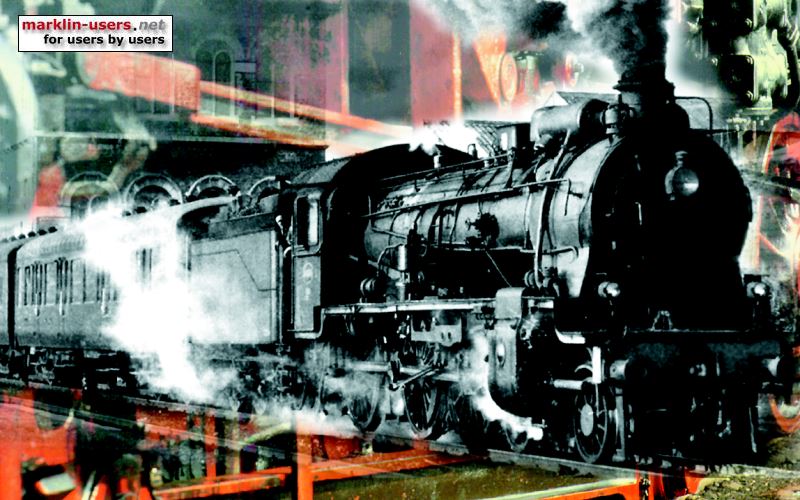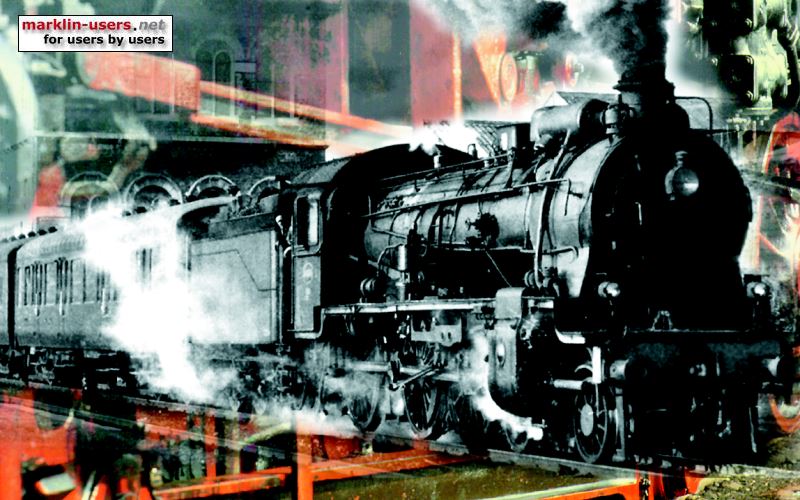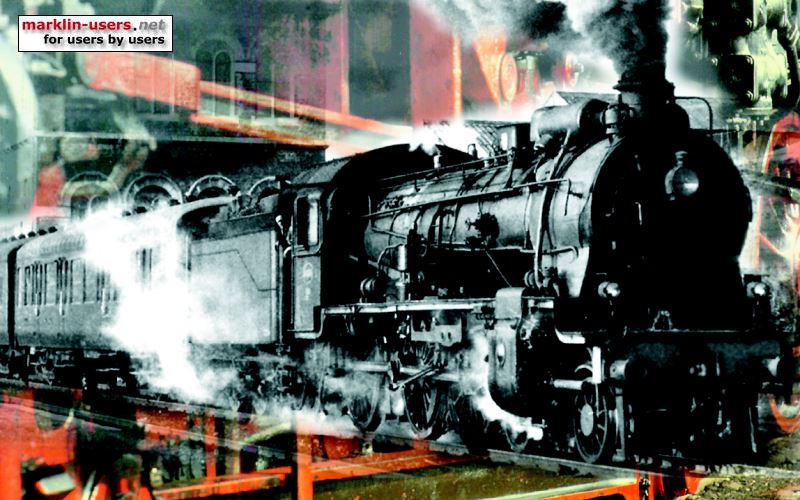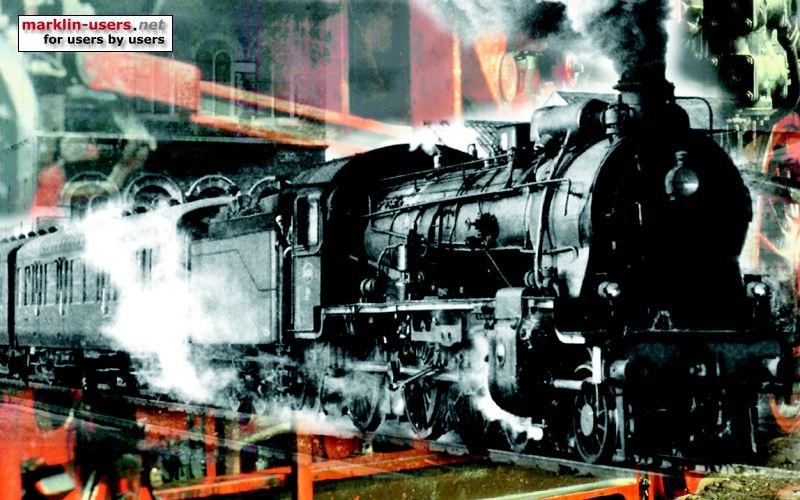 Joined: 29/05/2008(UTC) Posts: 272 Location: USA
|
Hello Marklin forum members!
I have been reading this website for a long time (years!) and I guess it is about time I join. [:o)] I have learned alot here about all aspects European railroading both miniture and full-size.
Here's my opening question for the panel of experts here:
How are gondolas unloaded? I'm talking about the most basic types like Marklin's 4601, 4604, or 4639. AFAIK these cars do not have hydraulic rams that would enable them to tip like a dump truck. So I have often wondered when I look at old pictures of gondola unit trains loaded with coal, "how do you unload a trainload of coal when using these cars?".
In Norfolk, Virgina I saw a rotary dumper that turned an entire gondola upside down in order to dump the coal which was then tranferred to a ship. Was something like this used? It doesn't seem like the european gondolas, especially the wood ones, are built stout enough for a rotary dumper...
Thanks, |
Marty
|
|
|
|
|
|
Joined: 03/01/2007(UTC)
Posts: 34
Location: ,
|
I would imagine something like a clamshell bucket on a machine of somekind would be one common method.
|
|
|
|
|
|
Joined: 04/11/2006(UTC)
Posts: 2,652
Location: New Zealand
|
Welcome Marty. To be honest, I always throught it was "The Armstrong Method" Similar to the way Kiwi's used to do it at least thru to the late '60 - '70's AFAIK Cheers Tony ps: And given the coupling method the rotary system would be a real pain  |
Lord Macca
New Zealand branch of Clan Donald.
|
|
|
|
|
|
 Joined: 14/03/2005(UTC) Posts: 15,871 Location: Gibraltar, Europe
|
If you look closely, you will see on those old gondolas a door in each side. All you need is a man with a shovel and a couple of hours.
Labour was cheap in those days!
Ray |
Ray
Mostly Marklin.Selection of different eras and European railways
Small C track layout, control by MS2, 100+ trains but run 4-5 at a time.
|
|
|
|
|
|
 Joined: 29/05/2008(UTC) Posts: 272 Location: USA
|
50-75 gondolas full of coal is alot of shovelling... ...and alot of time unless you have big crew content to do nothing but shovel all day.
By the way, the rotary dumper I mentioned was really quite the operation:
Fully loaded cars were qued up at the bottom of a ramp, and one by one they were towed up to the dumper using a cable. After unloading, the car was rotated right side up again, and then allowed to roll down a ramp to the large storage yard. The cars are banging into each other with a "boom" all day long. |
Marty
|
|
|
|
|
|
 Joined: 10/02/2006(UTC) Posts: 3,997
|
|
|
|
|
|
|
|
 Joined: 18/03/2007(UTC) Posts: 6,765 Location: Brisbane, Australia
|
Ray is quite correct, most unloading of gondolas was done by hand.
EXCEPT -
Many gondolas had doors in the floor that could be opened (in the US and UK), though I have not seen any European models with this feature.
Many gondolas had end doors (the complete end was hinged at the top) so when the wagon was tipped (lifted at one end by crane) the load would slide out the other end. I think some of my Marklin gondolas have end doors, but I cannot put my hands on them right now.
Also, there was often a pneumatic method available at some depots (giant suction type) to extract some loads.
regards
|
HO Scale - Märklin (ep II-III and VI, C Track, digital) - 2 rail HO (Queensland Australia, UK, USA) - 3 rail OO (English Hornby Dublo) - old clockwork O gauge - Live Steam 90mm (3.1/2 inch) gauge. |
|
|
|
|
|
 Joined: 14/03/2005(UTC) Posts: 15,871 Location: Gibraltar, Europe
|
The rotary dumper described by Marty is something I've always heard refered to as a "tippler". I believe Hornby used to make a working one, or was it Lima? I forget.
If we take coal as one of the most common loads, I believe it would have been loaded by some kind of gravity "chute" or other device at the mine or washing plant. This would then be destined for either an indutrial use, such as a steel works or power station, or for domestic use.
If the destination was industrial, there may have been some kind of mechanical means of unloading such as a tippler. If the coal was for domestic use, the gondolas would have been sorted into shorter trains which would almost certainly have been emptied by hand at the individual stations or goods yards.
Long trains of 50 to 75 wagons would have been unlikely, I think. 20 to 30 would have been considered a long train of the gondolas we are talking about.
Ray |
Ray
Mostly Marklin.Selection of different eras and European railways
Small C track layout, control by MS2, 100+ trains but run 4-5 at a time.
|
|
|
|
|
|
 Joined: 21/10/2004(UTC) Posts: 31,697 Location: United Kingdom
|
Welcome to the forum, Marty.  |
Large Marklinist 3- Rails Layout with CS2/MS2/Boosters/C-track/favorites Electric class E03/BR103, E18/E118, E94, Crocodiles/Steam BR01, BR03, BR05, BR23, BR44, BR50, Big Boy. |
|
|
|
|
|
Joined: 04/11/2006(UTC)
Posts: 2,652
Location: New Zealand
|
God Ray - That takes me back.
I think you are right, in the dusty recesses of my mind I seem to remember the Hornby model.
Dale - What kind of couplers do they use in SA?
Reason why I ask is that IMHO having to unscrew the Euro couplers must be a pain for single wagon tippers.
Cheers
Tony |
Lord Macca
New Zealand branch of Clan Donald.
|
|
|
|
|
|
 Joined: 25/03/2006(UTC) Posts: 858 Location: Connecticut, USA
|
My company is in the refuse/recycling industry and we currently ship 600-700 tons daily of construction and demolition debris from Connecticut to landfills in New York and Ohio. Whenever possible we prefer tipper equipped destinations because they reduce turn-around time and are much kinder to our gondolas. The alternative is to dig the material out of the car with a bucket loader which causes considerable damage over time. Also, this "old" method typically leaves several tons of material in the car. Most of our 200 cars are 5500cf capacity which translates to 90-100 tons of material. Trucking the same volume would require 4-5 100 cubic yard trailers. Daily outbound carloads number an average of 6. Turnaround time (from our tracks to landfill and back) averages a little under 3 weeks. Here is a photo of a state-of-the art three-car tipper. Notice that the car ends have no role to play - all gripping is from the sides.  At our "yard" we have recently invested in a car mover that has replaced some rather primitive DIY methodology. She is called a TrackMobile and looks like this (the file is *.gif - hope it translates):  As you know, tractive power is a function of weight which is applied in an innovative fashion with this machine. Notice the pair of steel wheels at the front. There is a hydraulic lift that fits under the car and gains the necessary weight by lifting the car thus gaining the required tractive weight from the car. A real case of necessity being the mother of invention - while certainly not inexpensive, it is far less expensive to buy, operate and maintain than a switcher. |
A Connecticut Yankee |
|
|
|
|
|
 Joined: 10/02/2006(UTC) Posts: 3,997
|
as far as I can recall the SA couplers are automatic knuckle claw types (no threading) |
|
|
|
|
|
|
 Joined: 10/02/2006(UTC) Posts: 3,997
|
I seem to recall some sort of 'dog' that was pulled by a cable, which drew the gondola up a steep slope in order to get the gondola high enough to tip its contents onto a conveyor. Cant remember if it was done one at a time or if 2 or three were done at a time... |
|
|
|
|
|
|
 Joined: 29/05/2008(UTC) Posts: 272 Location: USA
|
Thanks for the responses everyone! I knew I'd be glad I joined!
Soren36: Thanks for the wealth of info. It looks like those gondolas have "rotary couplers" - the shank of the coupler can rotate, thus making it unnecessary to uncouple the cars. Regarding the Trackmobile: This uses the same principle that I have seen on cement mixer trucks here in the US; there is a 2-wheeled trailer that transfers the weight of the truck to the trailer wheels via a hydraulic lift.
The gondolas I'm referring to date back to the steam era, so come to think of it, maybe manually unloading them was not out of the question - most steam locos had to constantly be manually fed! |
Marty
|
|
|
|
|
|
 Joined: 22/11/2006(UTC) Posts: 676 Location: Shoreline, WA
|
Soren, those are great photos!!! You should put together an article for Model Railroader magazine (if management would allow). MR is always looking for articles on modern track side industries. I learn something every time I get on this site. |
Thom
European Train Enthusiast - Pacific Northwest Chapter
4th Division, Pacific Northwest Region, National Model Railroaders Association |
|
|
|
|
|
Joined: 15/02/2004(UTC)
Posts: 1,591
Location: Pennsylvania
|
walthers in the USA used to make a plastic kit of a rotary dumper. Its discontinued now, and they don't seem to bring old kits back too often. It sells for quite a bit of money on ebay ($50-80). I bought one in a hobby shop near Pittsburgh a few years ago. there is a internet site of a guy who motorized his kit. http://members.trainorders.com/pmack/dumper.htm
|
|
|
|
|
|
Joined: 09/08/2007(UTC)
Posts: 67
Location: Saskatoon, Saskatchewan
|
Quote:[size=1" face="Verdana" id="quote]quote:Originally posted by Marty
<br />The gondolas I'm referring to date back to the steam era, so come to think of it, maybe manually unloading them was not out of the question - most steam locos had to constantly be manually fed!
It seems reasonable to suppose that manual unloading was the most common method up to about 1960. Larger operations would have used a crane with a clamshell bucket, but even this would be bound to leave several hundred kilograms of material in the corners of the car which would have to be shovelled out by hand (and also gradually cause damage to the cars). Tipping cars like class El-u 061 were introduced in about 1960, but there never were more than a few hundred of them - less than 1% of the total number of gondolas in service, although El-u 061 is the prototype for the well-known Märklin 4430 and 4431:  And while I hesitate to contaminate the forum with pictures of non-Märklin models, here's an image of the Liliput model of the same car which illustrates the tipping action (absent from the Märklin version): 
|
|
|
|
|
|
Joined: 09/08/2007(UTC)
Posts: 67
Location: Saskatoon, Saskatchewan
|
After making the above posting, it gradually dawned on me that many of the common classes of solid-bottomed gondolas had hinged end doors (hinged at the top, like the end gate of a dump truck), and I also (finally) remembered that there is an article in MIBA-Spezial 63 (pp. 56-61) on building a working model of a drawbridge-style installation which tips such a gondola on end and dumps the contents into a storage pit below track level. The article also describes modifying a Liliput Omm(r) 33 gondola by giving it hinged ends:  I have no idea how common such devices may have been. The article mentions one at a paper mill in Augsburg and cites a book (Siegfried Braun, Die Augsburger Localbahn, EK-Verlag) but does not provide any prototype photos or drawings. Presumably the tippers were common enough to justify equipping substantial numbers of gondolas with end gates - unless there was some other reason for having the gates.
|
|
|
|
|
|
 Joined: 08/11/2005(UTC) Posts: 3,528 Location: Mullerup, 4200 Slagelse
|
 Per. |
If you can dream it, you can do it! I, the copyright holder of this work, hereby release it into the public domain. This applies worldwide. In case this is not legally possible: I grant anyone the right to use this work for any purpose, without any conditions, unless such conditions are required by law.  |
|
|
|
|
|
 Joined: 25/03/2006(UTC) Posts: 858 Location: Connecticut, USA
|
|
A Connecticut Yankee |
|
|
|
|
|
Joined: 09/08/2007(UTC)
Posts: 67
Location: Saskatoon, Saskatchewan
|
Yes, very nice indeed - thanks, Per!
|
|
|
|
|
|
 Joined: 23/08/2006(UTC) Posts: 2,597 Location: Beverly, MA
|
Hi all, Hi Marty and welcome! Can you tell us what country you are asking about? Because some US steam loks were not feed coal manually,....Big boy for example Dr D Quote:[size=1" face="Verdana" id="quote]quote:Originally posted by Marty
<br />Thanks for the responses everyone! I knew I'd be glad I joined!
Soren36: Thanks for the wealth of info. It looks like those gondolas have "rotary couplers" - the shank of the coupler can rotate, thus making it unnecessary to uncouple the cars. Regarding the Trackmobile: This uses the same principle that I have seen on cement mixer trucks here in the US; there is a 2-wheeled trailer that transfers the weight of the truck to the trailer wheels via a hydraulic lift.
The gondolas I'm referring to date back to the steam era, so come to think of it, maybe manually unloading them was not out of the question - most steam locos had to constantly be manually fed!
 
|
|
|
|
|
|
 Joined: 29/05/2008(UTC) Posts: 272 Location: USA
|
Hi Dr.D,
The Marklin gondolas that I refer to in my initial post are of a typical western European design that were used in Germany, Holland, Belgium, etc.
I don't know the exact dates these types were in service, but I have seen this type hauling coal in WWII-era photos right through the '60's (at least).
I think the majority of German steam loks were manually fed coal burners; but there were exceptions, of course: oil burners, and stoker-fed coal burners. Another discussion topic should be created if you want to go into detail about this.
In the USA, rotary dumpers are not that unusual, but I haven't seen any pictures of something like this in Europe. |
Marty
|
|
|
|
|
|
 Joined: 23/08/2006(UTC) Posts: 2,597 Location: Beverly, MA
|
Hi,Marty, and once more,WELCOME! We might use 'Folks are glad to have another with us, "It warms the soul to know we aren't alone.' Dr Drit , there is something to be said 'bout a goods days work,... D of D Quote:[size=1" face="Verdana" id="quote]quote:Originally posted by Marty
<br />Hi Dr.D,
The Marklin gondolas that I refer to in my initial post are of a typical western European design that were used in Germany, Holland, Belgium, etc.
I don't know the exact dates these types were in service, but I have seen this type hauling coal in WWII-era photos right through the '60's (at least).
I think the majority of German steam loks were manually fed coal burners; but there were exceptions, of course: oil burners, and stoker-fed coal burners. Another discussion topic should be created if you want to go into detail about this.
In the USA, rotary dumpers are not that unusual, but I haven't seen any pictures of something like this in Europe.

|
|
|
|
|
|
Joined: 09/08/2007(UTC)
Posts: 67
Location: Saskatoon, Saskatchewan
|
Here's a scan of Bertold Langer's model from the MIBA-Spezial article mentioned above:  And here's a scan (apologies for the poor quality) of a photo of a prototype tipper (from p 6 of Gerd Wolff, Die offenen Güterwagen der Regelbauart, EK-Verlag 1991): 
|
|
|
|
|
|
 Joined: 29/05/2008(UTC) Posts: 272 Location: USA
|
... now it all makes sense... It looks from the picture that the wooden gondolas are braced by their axles during the tipping. The wooden walls don't have to be heavily reinforced because the load path is through the steel underframe and axles.
Although the gondolas have to be individually uncoupled, it sure beats shovelling!
Thanks for all the research! |
Marty
|
|
|
|
|
|
Joined: 04/11/2006(UTC)
Posts: 2,652
Location: New Zealand
|
Great photos Mark. Thanks. I'm gettin an idea here   Marty thanks once again for bringing this topic up |
Lord Macca
New Zealand branch of Clan Donald.
|
|
|
|
|
|
Joined: 09/08/2007(UTC)
Posts: 67
Location: Saskatoon, Saskatchewan
|
|
|
|
|
|
|
 Joined: 21/10/2004(UTC) Posts: 31,697 Location: United Kingdom
|
Never seen it before! Thanks for the pictures, Ladislas.
|
Large Marklinist 3- Rails Layout with CS2/MS2/Boosters/C-track/favorites Electric class E03/BR103, E18/E118, E94, Crocodiles/Steam BR01, BR03, BR05, BR23, BR44, BR50, Big Boy. |
|
|
|
|
|
 Joined: 29/05/2008(UTC) Posts: 272 Location: USA
|
Has anyone noticed that both of the two pictures of the model tippers have the gondola resting on rails, yet the black and white picture clearly shows the tipper supporting the gondola's axles, and not its wheels. The tipper is mounted between the rails; the rails don't move at all. Purists take note!  |
Marty
|
|
|
|
|
|
Joined: 04/11/2006(UTC)
Posts: 2,652
Location: New Zealand
|
Marty,
Yes I had spotted that and my first reaction was the 2 rail operation ok but it will be a real pain for 3 rail.... |
Lord Macca
New Zealand branch of Clan Donald.
|
|
|
|
|
|
Forum Jump
You cannot post new topics in this forum.
You cannot reply to topics in this forum.
You cannot delete your posts in this forum.
You cannot edit your posts in this forum.
You cannot create polls in this forum.
You cannot vote in polls in this forum.